python的requests模块详解
原文链接:https://www.cnblogs.com/lanyinhao/p/9634742.html
1、模块说明
requests是使用Apache2 licensed 许可证的HTTP库。
用python编写。
比urllib2模块更简洁。
Request支持HTTP连接保持和连接池,支持使用cookie保持会话,支持文件上传,支持自动响应内容的编码,支持国际化的URL和POST数据自动编码。
在python内置模块的基础上进行了高度的封装,从而使得python进行网络请求时,变得人性化,使用Requests可以轻而易举的完成浏览器可有的任何操作。
现代,国际化,友好。
requests会自动实现持久连接keep-alive
2、基础入门
1)导入模块
import requests
2)发送请求的简洁
示例代码:获取一个网页(个人github)
import requests
r = requests.get('https://github.com/Ranxf') # 最基本的不带参数的get请求
r1 = requests.get(url='http://dict.baidu.com/s', params={'wd': '小马'}) # 带参数的get请求
不带参数:

带参数:


我们就可以使用该方式使用以下各种方法
1 requests.get(‘https://github.com/timeline.json’) # GET请求
2 requests.post(“http://httpbin.org/post”) # POST请求
3 requests.put(“http://httpbin.org/put”) # PUT请求
4 requests.delete(“http://httpbin.org/delete”) # DELETE请求
5 requests.head(“http://httpbin.org/get”) # HEAD请求
6 requests.options(“http://httpbin.org/get” ) # OPTIONS请求
3)为url传递参数,#获取请求的url(包含参数)
>>> url_params = {'key':'value'} # 字典传递参数,如果值为None的键不会被添加到url中
>>> r = requests.get('your url',params = url_params)
>>> print(r.url)
your url?key=value


4)响应的内容

r.encoding #获取当前的编码
r.encoding = 'utf-8' #设置编码
r.text #以encoding解析返回内容。字符串方式的响应体,会自动根据响应头部的字符编码进行解码。
r.content #以字节形式(二进制)返回。字节方式的响应体,会自动为你解码 gzip 和 deflate 压缩。 r.headers #以字典对象存储服务器响应头,但是这个字典比较特殊,字典键不区分大小写,若键不存在则返回None r.status_code #响应状态码
r.raw #返回原始响应体,也就是 urllib 的 response 对象,使用 r.raw.read()
r.ok # 查看r.ok的布尔值便可以知道是否登陆成功
#*特殊方法*#
r.json() #Requests中内置的JSON解码器,以json形式返回,前提返回的内容确保是json格式的,不然解析出错会抛异常
r.raise_for_status() #失败请求(非200响应)抛出异常

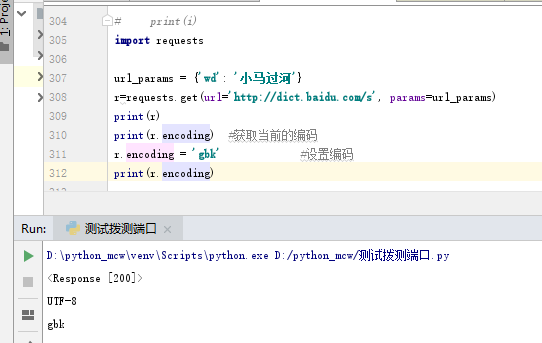
r.txt
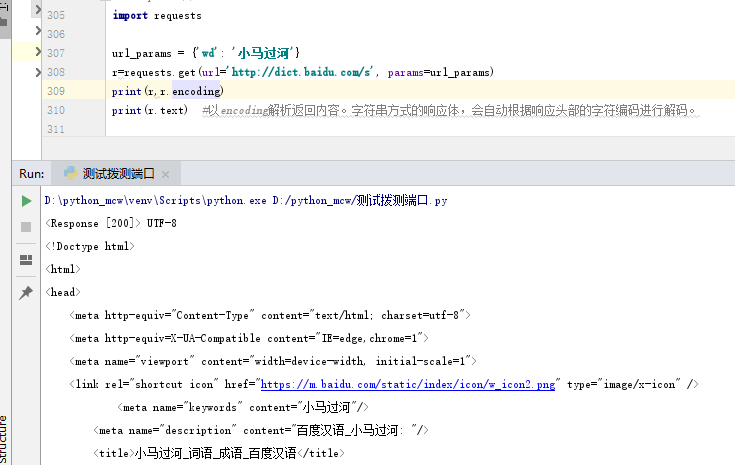
r.content

r.header

r.status_code
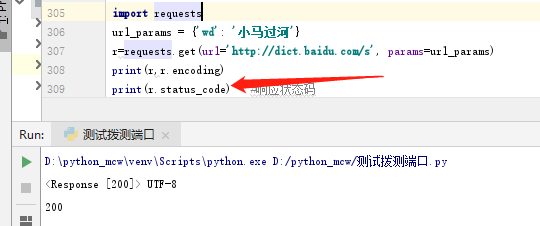
r.raw


这是要请求的接口结果,视图函数,以及requests模块请求结果:

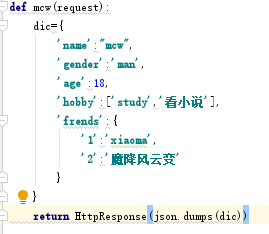

假如返回的不是json格式:

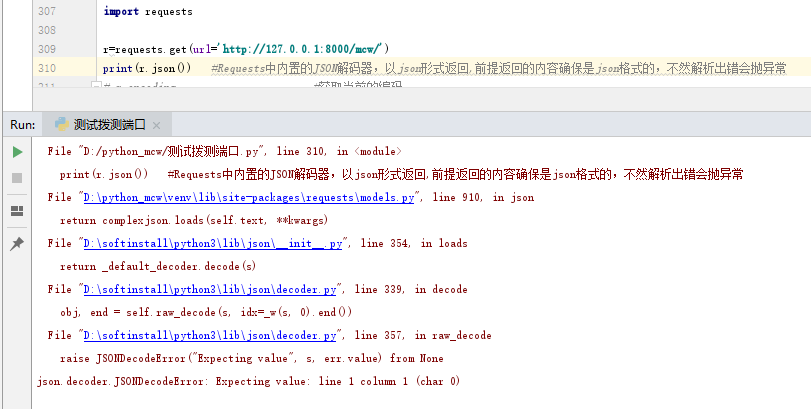
r.raise_for_status()
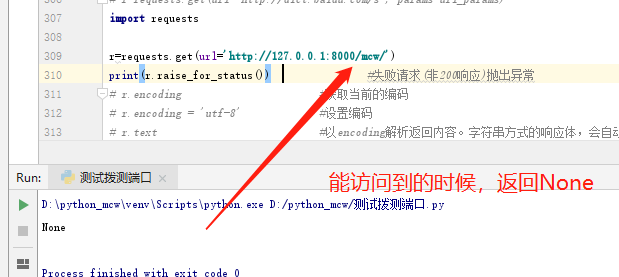
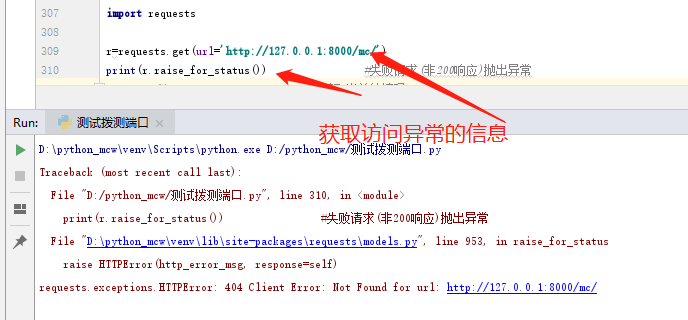
前端中文要正常显示,这里要加参数


post发送json请求:
1 import requests
2 import json
3
4 r = requests.post('https://api.github.com/some/endpoint', data=json.dumps({'some': 'data'}))
5 print(r.json())
视图函数:
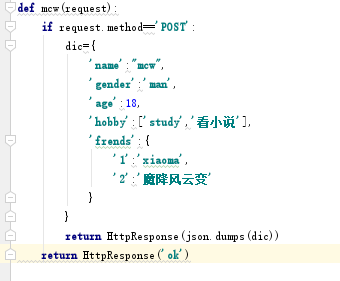
get请求:
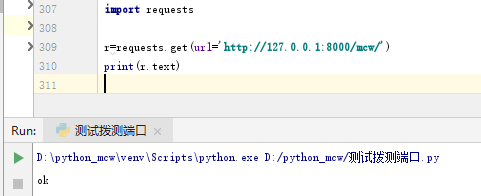
post请求:

加参数的post请求
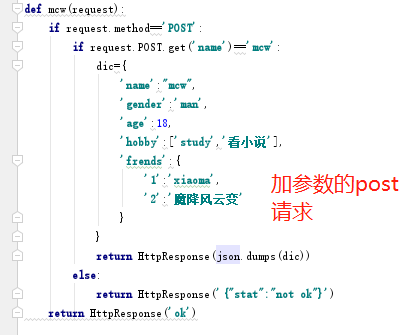


5)定制头和cookie信息
header = {'user-agent': 'my-app/0.0.1''}
cookie = {'key':'value'}
r = requests.get/post('your url',headers=header,cookies=cookie)
data = {'some': 'data'}
headers = {'content-type': 'application/json',
'User-Agent': 'Mozilla/5.0 (X11; Ubuntu; Linux x86_64; rv:22.0) Gecko/20100101 Firefox/22.0'}
r = requests.post('https://api.github.com/some/endpoint', data=data, headers=headers)
print(r.text)

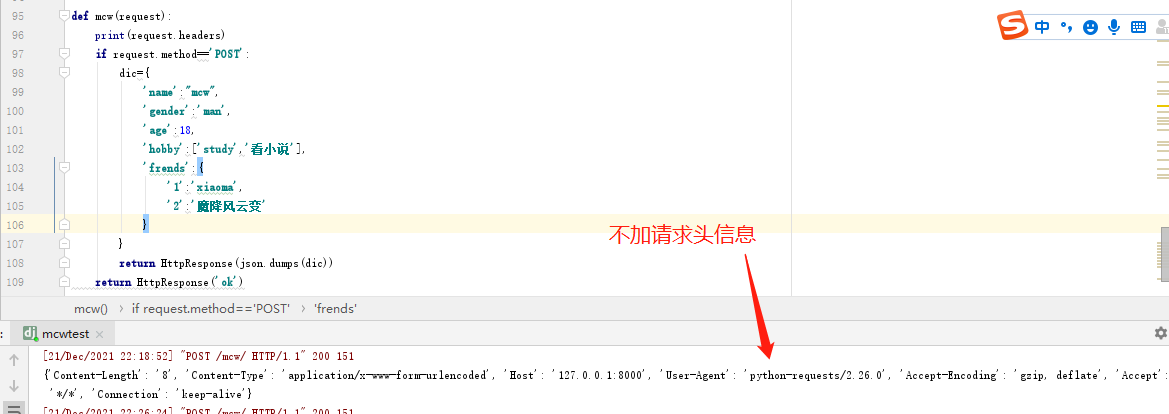
添加请求头信息之后:

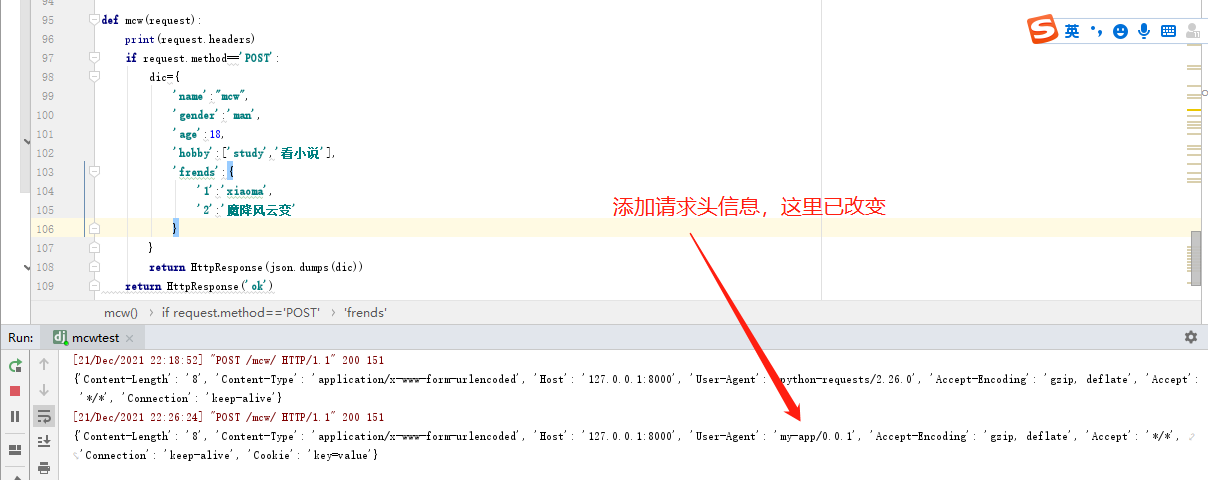
修改请求内容类型为json,用户使用火狐浏览器访问

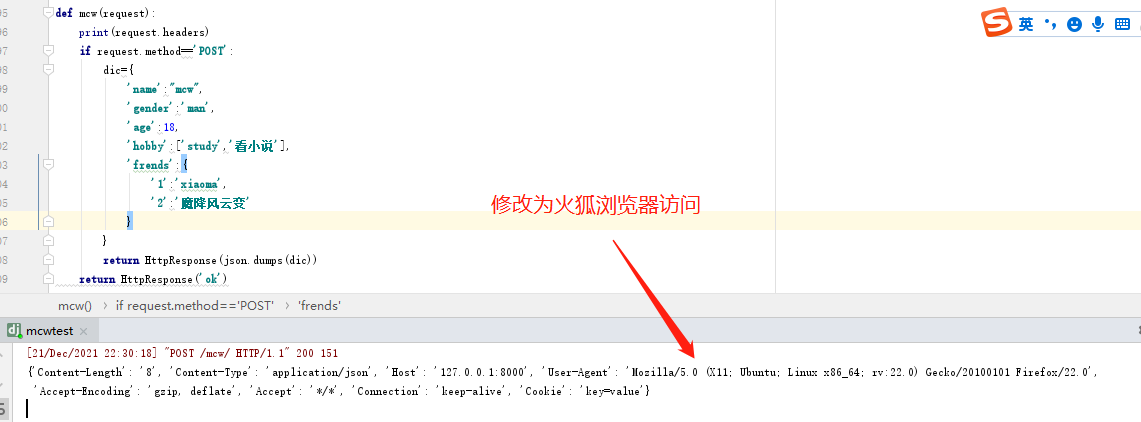
cookie放在cookies里没成功,把键值对放到请求头成功了。回头研究一下,再
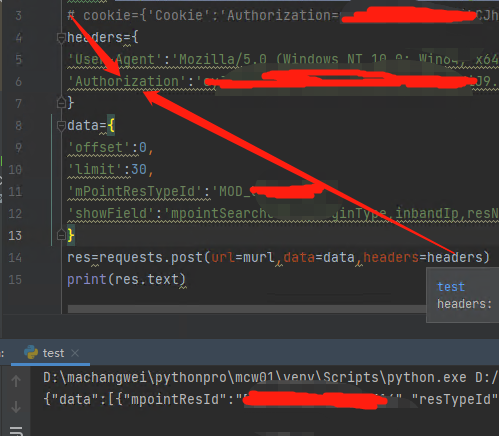
6)响应状态码
使用requests方法后,会返回一个response对象,其存储了服务器响应的内容,如上实例中已经提到的 r.text、r.status_code……
获取文本方式的响应体实例:当你访问 r.text 之时,会使用其响应的文本编码进行解码,并且你可以修改其编码让 r.text 使用自定义的编码进行解码。
1 r = requests.get('http://www.itwhy.org')
2 print(r.text, '\n{}\n'.format('*'*79), r.encoding)
3 r.encoding = 'GBK'
4 print(r.text, '\n{}\n'.format('*'*79), r.encoding)
示例代码:

1 import requests
2
3 r = requests.get('https://github.com/Ranxf') # 最基本的不带参数的get请求
4 print(r.status_code) # 获取返回状态
5 r1 = requests.get(url='http://dict.baidu.com/s', params={'wd': 'python'}) # 带参数的get请求
6 print(r1.url)
7 print(r1.text) # 打印解码后的返回数据

运行结果:
/usr/bin/python3.5 /home/rxf/python3_1000/1000/python3_server/python3_requests/demo1.py
200
http://dict.baidu.com/s?wd=python
………… Process finished with exit code 0
r.status_code #如果不是200,可以使用 r.raise_for_status() 抛出异常
7)响应
r.headers #返回字典类型,头信息
r.requests.headers #返回发送到服务器的头信息 #这个不清楚是个啥呢
r.cookies #返回cookie
r.history #返回重定向信息,当然可以在请求是加上allow_redirects = false 阻止重定向


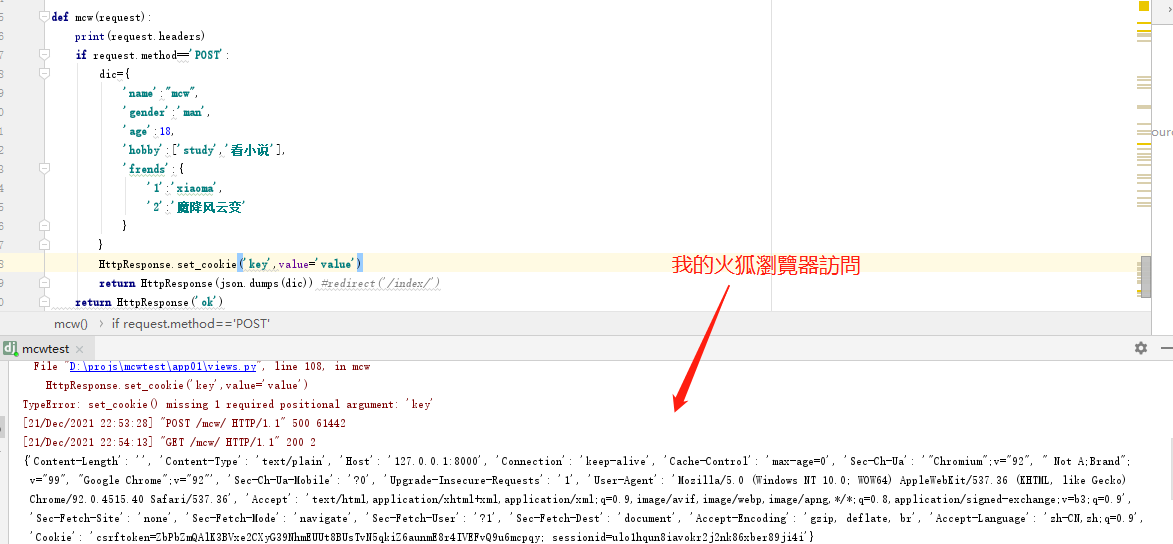
8)超时
r = requests.get('url',timeout=1) #设置秒数超时,仅对于连接有效

这边设置超时时间1秒,但是响应时间是2秒,所以超时了,报错读取超时

9)会话对象,能够跨请求保持某些参数
s = requests.Session()
s.auth = ('auth','passwd')
s.headers = {'key':'value'}
r = s.get('url')
r1 = s.get('url1')
10)代理
proxies = {'http':'ip1','https':'ip2' }
requests.get('url',proxies=proxies)
汇总:

# HTTP请求类型
# get类型
r = requests.get('https://github.com/timeline.json')
# post类型
r = requests.post("http://m.ctrip.com/post")
# put类型
r = requests.put("http://m.ctrip.com/put")
# delete类型
r = requests.delete("http://m.ctrip.com/delete")
# head类型
r = requests.head("http://m.ctrip.com/head")
# options类型
r = requests.options("http://m.ctrip.com/get") # 获取响应内容
print(r.content) #以字节的方式去显示,中文显示为字符
print(r.text) #以文本的方式去显示 #URL传递参数
payload = {'keyword': '香港', 'salecityid': '2'}
r = requests.get("http://m.ctrip.com/webapp/tourvisa/visa_list", params=payload)
print(r.url) #示例为http://m.ctrip.com/webapp/tourvisa/visa_list?salecityid=2&keyword=香港 #获取/修改网页编码
r = requests.get('https://github.com/timeline.json')
print (r.encoding) #json处理
r = requests.get('https://github.com/timeline.json')
print(r.json()) # 需要先import json # 定制请求头
url = 'http://m.ctrip.com'
headers = {'User-Agent' : 'Mozilla/5.0 (Linux; Android 4.2.1; en-us; Nexus 4 Build/JOP40D) AppleWebKit/535.19 (KHTML, like Gecko) Chrome/18.0.1025.166 Mobile Safari/535.19'}
r = requests.post(url, headers=headers)
print (r.request.headers) #复杂post请求
url = 'http://m.ctrip.com'
payload = {'some': 'data'}
r = requests.post(url, data=json.dumps(payload)) #如果传递的payload是string而不是dict,需要先调用dumps方法格式化一下 # post多部分编码文件
url = 'http://m.ctrip.com'
files = {'file': open('report.xls', 'rb')}
r = requests.post(url, files=files) # 响应状态码
r = requests.get('http://m.ctrip.com')
print(r.status_code) # 响应头
r = requests.get('http://m.ctrip.com')
print (r.headers)
print (r.headers['Content-Type'])
print (r.headers.get('content-type')) #访问响应头部分内容的两种方式 # Cookies
url = 'http://example.com/some/cookie/setting/url'
r = requests.get(url)
r.cookies['example_cookie_name'] #读取cookies url = 'http://m.ctrip.com/cookies'
cookies = dict(cookies_are='working')
r = requests.get(url, cookies=cookies) #发送cookies #设置超时时间
r = requests.get('http://m.ctrip.com', timeout=0.001) #设置访问代理
proxies = {
"http": "http://10.10.1.10:3128",
"https": "http://10.10.1.100:4444",
}
r = requests.get('http://m.ctrip.com', proxies=proxies) #如果代理需要用户名和密码,则需要这样:
proxies = {
"http": "http://user:pass@10.10.1.10:3128/",
}


# HTTP请求类型
# get类型
r = requests.get('https://github.com/timeline.json')
# post类型
r = requests.post("http://m.ctrip.com/post")
# put类型
r = requests.put("http://m.ctrip.com/put")
# delete类型
r = requests.delete("http://m.ctrip.com/delete")
# head类型
r = requests.head("http://m.ctrip.com/head")
# options类型
r = requests.options("http://m.ctrip.com/get") # 获取响应内容
print(r.content) #以字节的方式去显示,中文显示为字符
print(r.text) #以文本的方式去显示 #URL传递参数
payload = {'keyword': '香港', 'salecityid': '2'}
r = requests.get("http://m.ctrip.com/webapp/tourvisa/visa_list", params=payload)
print(r.url) #示例为http://m.ctrip.com/webapp/tourvisa/visa_list?salecityid=2&keyword=香港 #获取/修改网页编码
r = requests.get('https://github.com/timeline.json')
print (r.encoding) #json处理
r = requests.get('https://github.com/timeline.json')
print(r.json()) # 需要先import json # 定制请求头
url = 'http://m.ctrip.com'
headers = {'User-Agent' : 'Mozilla/5.0 (Linux; Android 4.2.1; en-us; Nexus 4 Build/JOP40D) AppleWebKit/535.19 (KHTML, like Gecko) Chrome/18.0.1025.166 Mobile Safari/535.19'}
r = requests.post(url, headers=headers)
print (r.request.headers) #复杂post请求
url = 'http://m.ctrip.com'
payload = {'some': 'data'}
r = requests.post(url, data=json.dumps(payload)) #如果传递的payload是string而不是dict,需要先调用dumps方法格式化一下 # post多部分编码文件
url = 'http://m.ctrip.com'
files = {'file': open('report.xls', 'rb')}
r = requests.post(url, files=files) # 响应状态码
r = requests.get('http://m.ctrip.com')
print(r.status_code) # 响应头
r = requests.get('http://m.ctrip.com')
print (r.headers)
print (r.headers['Content-Type'])
print (r.headers.get('content-type')) #访问响应头部分内容的两种方式 # Cookies
url = 'http://example.com/some/cookie/setting/url'
r = requests.get(url)
r.cookies['example_cookie_name'] #读取cookies url = 'http://m.ctrip.com/cookies'
cookies = dict(cookies_are='working')
r = requests.get(url, cookies=cookies) #发送cookies #设置超时时间
r = requests.get('http://m.ctrip.com', timeout=0.001) #设置访问代理
proxies = {
"http": "http://10.10.1.10:3128",
"https": "http://10.10.1.100:4444",
}
r = requests.get('http://m.ctrip.com', proxies=proxies) #如果代理需要用户名和密码,则需要这样:
proxies = {
"http": "http://user:pass@10.10.1.10:3128/",
}

其它:
3、示例代码
GET请求

1 # 1、无参数实例
2
3 import requests
4
5 ret = requests.get('https://github.com/timeline.json')
6
7 print(ret.url)
8 print(ret.text)
9
10
11
12 # 2、有参数实例
13
14 import requests
15
16 payload = {'key1': 'value1', 'key2': 'value2'}
17 ret = requests.get("http://httpbin.org/get", params=payload)
18
19 print(ret.url)
20 print(ret.text)

POST请求

# 1、基本POST实例
import requests
payload = {'key1': 'value1', 'key2': 'value2'}
ret = requests.post("http://httpbin.org/post", data=payload)
print(ret.text)
# 2、发送请求头和数据实例
import requests
import json
url = 'https://api.github.com/some/endpoint'
payload = {'some': 'data'}
headers = {'content-type': 'application/json'}
ret = requests.post(url, data=json.dumps(payload), headers=headers)
print(ret.text)
print(ret.cookies)

请求参数
 请求参数
请求参数 参数示例代码
参数示例代码json请求:

#! /usr/bin/python3
import requests
import json class url_request():
def __init__(self):
''' init ''' if __name__ == '__main__':
heard = {'Content-Type': 'application/json'}
payload = {'CountryName': '中国',
'ProvinceName': '四川省',
'L1CityName': 'chengdu',
'L2CityName': 'yibing',
'TownName': '',
'Longitude': '107.33393',
'Latitude': '33.157131',
'Language': 'CN'}
r = requests.post("http://www.xxxxxx.com/CityLocation/json/LBSLocateCity", heards=heard, data=payload)
data = r.json()
if r.status_code!=200:
print('LBSLocateCity API Error' + str(r.status_code))
print(data['CityEntities'][0]['CityID']) # 打印返回json中的某个key的value
print(data['ResponseStatus']['Ack'])
print(json.dump(data, indent=4, sort_keys=True, ensure_ascii=False)) # 树形打印json,ensure_ascii必须设为False否则中文会显示为unicode

Xml请求:

#! /usr/bin/python3
import requests class url_request():
def __init__(self):
"""init""" if __name__ == '__main__':
heards = {'Content-type': 'text/xml'}
XML = '<?xml version="1.0" encoding="utf-8"?><soap:Envelope xmlns:xsi="http://www.w3.org/2001/XMLSchema-instance" xmlns:xsd="http://www.w3.org/2001/XMLSchema" xmlns:soap="http://schemas.xmlsoap.org/soap/envelope/"><soap:Body><Request xmlns="http://tempuri.org/"><jme><JobClassFullName>WeChatJSTicket.JobWS.Job.JobRefreshTicket,WeChatJSTicket.JobWS</JobClassFullName><Action>RUN</Action><Param>1</Param><HostIP>127.0.0.1</HostIP><JobInfo>1</JobInfo><NeedParallel>false</NeedParallel></jme></Request></soap:Body></soap:Envelope>'
url = 'http://jobws.push.mobile.xxxxxxxx.com/RefreshWeiXInTokenJob/RefreshService.asmx'
r = requests.post(url=url, heards=heards, data=XML)
data = r.text
print(data)

状态异常处理

import requests URL = 'http://ip.taobao.com/service/getIpInfo.php' # 淘宝IP地址库API
try:
r = requests.get(URL, params={'ip': '8.8.8.8'}, timeout=1)
r.raise_for_status() # 如果响应状态码不是 200,就主动抛出异常
except requests.RequestException as e:
print(e)
else:
result = r.json()
print(type(result), result, sep='\n')

上传文件
使用request模块,也可以上传文件,文件的类型会自动进行处理:

import requests url = 'http://127.0.0.1:8080/upload'
files = {'file': open('/home/rxf/test.jpg', 'rb')}
#files = {'file': ('report.jpg', open('/home/lyb/sjzl.mpg', 'rb'))} #显式的设置文件名 r = requests.post(url, files=files)
print(r.text)

request更加方便的是,可以把字符串当作文件进行上传:

import requests url = 'http://127.0.0.1:8080/upload'
files = {'file': ('test.txt', b'Hello Requests.')} #必需显式的设置文件名 r = requests.post(url, files=files)
print(r.text)

6) 身份验证
基本身份认证(HTTP Basic Auth)
import requests
from requests.auth import HTTPBasicAuth r = requests.get('https://httpbin.org/hidden-basic-auth/user/passwd', auth=HTTPBasicAuth('user', 'passwd'))
# r = requests.get('https://httpbin.org/hidden-basic-auth/user/passwd', auth=('user', 'passwd')) # 简写
print(r.json())
另一种非常流行的HTTP身份认证形式是摘要式身份认证,Requests对它的支持也是开箱即可用的:
requests.get(URL, auth=HTTPDigestAuth('user', 'pass')
Cookies与会话对象
如果某个响应中包含一些Cookie,你可以快速访问它们:
import requests
r = requests.get('http://www.google.com.hk/')
print(r.cookies['NID'])
print(tuple(r.cookies))
要想发送你的cookies到服务器,可以使用 cookies 参数:

import requests url = 'http://httpbin.org/cookies'
cookies = {'testCookies_1': 'Hello_Python3', 'testCookies_2': 'Hello_Requests'}
# 在Cookie Version 0中规定空格、方括号、圆括号、等于号、逗号、双引号、斜杠、问号、@,冒号,分号等特殊符号都不能作为Cookie的内容。
r = requests.get(url, cookies=cookies)
print(r.json())

会话对象让你能够跨请求保持某些参数,最方便的是在同一个Session实例发出的所有请求之间保持cookies,且这些都是自动处理的,甚是方便。
下面就来一个真正的实例,如下是快盘签到脚本:

import requests
headers = {'Accept': 'text/html,application/xhtml+xml,application/xml;q=0.9,*/*;q=0.8',
'Accept-Encoding': 'gzip, deflate, compress',
'Accept-Language': 'en-us;q=0.5,en;q=0.3',
'Cache-Control': 'max-age=0',
'Connection': 'keep-alive',
'User-Agent': 'Mozilla/5.0 (X11; Ubuntu; Linux x86_64; rv:22.0) Gecko/20100101 Firefox/22.0'}
s = requests.Session()
s.headers.update(headers)
# s.auth = ('superuser', '123')
s.get('https://www.kuaipan.cn/account_login.htm')
_URL = 'http://www.kuaipan.cn/index.php'
s.post(_URL, params={'ac':'account', 'op':'login'},
data={'username':'****@foxmail.com', 'userpwd':'********', 'isajax':'yes'})
r = s.get(_URL, params={'ac':'zone', 'op':'taskdetail'})
print(r.json())
s.get(_URL, params={'ac':'common', 'op':'usersign'})

requests模块抓取网页源码并保存到文件示例
这是一个基本的文件保存操作,但这里有几个值得注意的问题:
1.安装requests包,命令行输入pip install requests即可自动安装。很多人推荐使用requests,自带的urllib.request也可以抓取网页源码
2.open方法encoding参数设为utf-8,否则保存的文件会出现乱码。
3.如果直接在cmd中输出抓取的内容,会提示各种编码错误,所以保存到文件查看。
4.with open方法是更好的写法,可以自动操作完毕后释放资源

#! /urs/bin/python3
import requests '''requests模块抓取网页源码并保存到文件示例'''
html = requests.get("http://www.baidu.com")
with open('test.txt', 'w', encoding='utf-8') as f:
f.write(html.text) '''读取一个txt文件,每次读取一行,并保存到另一个txt文件中的示例'''
ff = open('testt.txt', 'w', encoding='utf-8')
with open('test.txt', encoding="utf-8") as f:
for line in f:
ff.write(line)
ff.close()

因为在命令行中打印每次读取一行的数据,中文会出现编码错误,所以每次读取一行并保存到另一个文件,这样来测试读取是否正常。(注意open的时候制定encoding编码方式)
自动登陆"示例:
 抽屉新热榜
抽屉新热榜

#!/usr/bin/env python
# -*- coding:utf-8 -*- import requests
from bs4 import BeautifulSoup # ############## 方式一 ##############
#
# # 1. 访问登陆页面,获取 authenticity_token
# i1 = requests.get('https://github.com/login')
# soup1 = BeautifulSoup(i1.text, features='lxml')
# tag = soup1.find(name='input', attrs={'name': 'authenticity_token'})
# authenticity_token = tag.get('value')
# c1 = i1.cookies.get_dict()
# i1.close()
#
# # 1. 携带authenticity_token和用户名密码等信息,发送用户验证
# form_data = {
# "authenticity_token": authenticity_token,
# "utf8": "",
# "commit": "Sign in",
# "login": "wupeiqi@live.com",
# 'password': 'xxoo'
# }
#
# i2 = requests.post('https://github.com/session', data=form_data, cookies=c1)
# c2 = i2.cookies.get_dict()
# c1.update(c2)
# i3 = requests.get('https://github.com/settings/repositories', cookies=c1)
#
# soup3 = BeautifulSoup(i3.text, features='lxml')
# list_group = soup3.find(name='div', class_='listgroup')
#
# from bs4.element import Tag
#
# for child in list_group.children:
# if isinstance(child, Tag):
# project_tag = child.find(name='a', class_='mr-1')
# size_tag = child.find(name='small')
# temp = "项目:%s(%s); 项目路径:%s" % (project_tag.get('href'), size_tag.string, project_tag.string, )
# print(temp) # ############## 方式二 ##############
# session = requests.Session()
# # 1. 访问登陆页面,获取 authenticity_token
# i1 = session.get('https://github.com/login')
# soup1 = BeautifulSoup(i1.text, features='lxml')
# tag = soup1.find(name='input', attrs={'name': 'authenticity_token'})
# authenticity_token = tag.get('value')
# c1 = i1.cookies.get_dict()
# i1.close()
#
# # 1. 携带authenticity_token和用户名密码等信息,发送用户验证
# form_data = {
# "authenticity_token": authenticity_token,
# "utf8": "",
# "commit": "Sign in",
# "login": "wupeiqi@live.com",
# 'password': 'xxoo'
# }
#
# i2 = session.post('https://github.com/session', data=form_data)
# c2 = i2.cookies.get_dict()
# c1.update(c2)
# i3 = session.get('https://github.com/settings/repositories')
#
# soup3 = BeautifulSoup(i3.text, features='lxml')
# list_group = soup3.find(name='div', class_='listgroup')
#
# from bs4.element import Tag
#
# for child in list_group.children:
# if isinstance(child, Tag):
# project_tag = child.find(name='a', class_='mr-1')
# size_tag = child.find(name='small')
# temp = "项目:%s(%s); 项目路径:%s" % (project_tag.get('href'), size_tag.string, project_tag.string, )
# print(temp)



#!/usr/bin/env python
# -*- coding:utf-8 -*-
import time import requests
from bs4 import BeautifulSoup session = requests.Session() i1 = session.get(
url='https://www.zhihu.com/#signin',
headers={
'User-Agent': 'Mozilla/5.0 (Macintosh; Intel Mac OS X 10_10_5) AppleWebKit/537.36 (KHTML, like Gecko) Chrome/54.0.2840.98 Safari/537.36',
}
) soup1 = BeautifulSoup(i1.text, 'lxml')
xsrf_tag = soup1.find(name='input', attrs={'name': '_xsrf'})
xsrf = xsrf_tag.get('value') current_time = time.time()
i2 = session.get(
url='https://www.zhihu.com/captcha.gif',
params={'r': current_time, 'type': 'login'},
headers={
'User-Agent': 'Mozilla/5.0 (Macintosh; Intel Mac OS X 10_10_5) AppleWebKit/537.36 (KHTML, like Gecko) Chrome/54.0.2840.98 Safari/537.36',
}) with open('zhihu.gif', 'wb') as f:
f.write(i2.content) captcha = input('请打开zhihu.gif文件,查看并输入验证码:')
form_data = {
"_xsrf": xsrf,
'password': 'xxooxxoo',
"captcha": 'captcha',
'email': '424662508@qq.com'
}
i3 = session.post(
url='https://www.zhihu.com/login/email',
data=form_data,
headers={
'User-Agent': 'Mozilla/5.0 (Macintosh; Intel Mac OS X 10_10_5) AppleWebKit/537.36 (KHTML, like Gecko) Chrome/54.0.2840.98 Safari/537.36',
}
) i4 = session.get(
url='https://www.zhihu.com/settings/profile',
headers={
'User-Agent': 'Mozilla/5.0 (Macintosh; Intel Mac OS X 10_10_5) AppleWebKit/537.36 (KHTML, like Gecko) Chrome/54.0.2840.98 Safari/537.36',
}
) soup4 = BeautifulSoup(i4.text, 'lxml')
tag = soup4.find(id='rename-section')
nick_name = tag.find('span',class_='name').string
print(nick_name)



#!/usr/bin/env python
# -*- coding:utf-8 -*-
import re
import json
import base64 import rsa
import requests def js_encrypt(text):
b64der = 'MIGfMA0GCSqGSIb3DQEBAQUAA4GNADCBiQKBgQCp0wHYbg/NOPO3nzMD3dndwS0MccuMeXCHgVlGOoYyFwLdS24Im2e7YyhB0wrUsyYf0/nhzCzBK8ZC9eCWqd0aHbdgOQT6CuFQBMjbyGYvlVYU2ZP7kG9Ft6YV6oc9ambuO7nPZh+bvXH0zDKfi02prknrScAKC0XhadTHT3Al0QIDAQAB'
der = base64.standard_b64decode(b64der) pk = rsa.PublicKey.load_pkcs1_openssl_der(der)
v1 = rsa.encrypt(bytes(text, 'utf8'), pk)
value = base64.encodebytes(v1).replace(b'\n', b'')
value = value.decode('utf8') return value session = requests.Session() i1 = session.get('https://passport.cnblogs.com/user/signin')
rep = re.compile("'VerificationToken': '(.*)'")
v = re.search(rep, i1.text)
verification_token = v.group(1) form_data = {
'input1': js_encrypt('wptawy'),
'input2': js_encrypt('asdfasdf'),
'remember': False
} i2 = session.post(url='https://passport.cnblogs.com/user/signin',
data=json.dumps(form_data),
headers={
'Content-Type': 'application/json; charset=UTF-8',
'X-Requested-With': 'XMLHttpRequest',
'VerificationToken': verification_token}
) i3 = session.get(url='https://i.cnblogs.com/EditDiary.aspx') print(i3.text)



#!/usr/bin/env python
# -*- coding:utf-8 -*- import requests # 第一步:访问登陆页,拿到X_Anti_Forge_Token,X_Anti_Forge_Code
# 1、请求url:https://passport.lagou.com/login/login.html
# 2、请求方法:GET
# 3、请求头:
# User-agent
r1 = requests.get('https://passport.lagou.com/login/login.html',
headers={
'User-Agent': 'Mozilla/5.0 (Windows NT 6.1; WOW64) AppleWebKit/537.36 (KHTML, like Gecko) Chrome/63.0.3239.132 Safari/537.36',
},
) X_Anti_Forge_Token = re.findall("X_Anti_Forge_Token = '(.*?)'", r1.text, re.S)[0]
X_Anti_Forge_Code = re.findall("X_Anti_Forge_Code = '(.*?)'", r1.text, re.S)[0]
print(X_Anti_Forge_Token, X_Anti_Forge_Code)
# print(r1.cookies.get_dict())
# 第二步:登陆
# 1、请求url:https://passport.lagou.com/login/login.json
# 2、请求方法:POST
# 3、请求头:
# cookie
# User-agent
# Referer:https://passport.lagou.com/login/login.html
# X-Anit-Forge-Code:53165984
# X-Anit-Forge-Token:3b6a2f62-80f0-428b-8efb-ef72fc100d78
# X-Requested-With:XMLHttpRequest
# 4、请求体:
# isValidate:true
# username:15131252215
# password:ab18d270d7126ea65915c50288c22c0d
# request_form_verifyCode:''
# submit:''
r2 = requests.post(
'https://passport.lagou.com/login/login.json',
headers={
'User-Agent': 'Mozilla/5.0 (Windows NT 6.1; WOW64) AppleWebKit/537.36 (KHTML, like Gecko) Chrome/63.0.3239.132 Safari/537.36',
'Referer': 'https://passport.lagou.com/login/login.html',
'X-Anit-Forge-Code': X_Anti_Forge_Code,
'X-Anit-Forge-Token': X_Anti_Forge_Token,
'X-Requested-With': 'XMLHttpRequest'
},
data={
"isValidate": True,
'username': '15131255089',
'password': 'ab18d270d7126ea65915c50288c22c0d',
'request_form_verifyCode': '',
'submit': ''
},
cookies=r1.cookies.get_dict()
)
print(r2.text)

参考:
http://cn.python-requests.org/zh_CN/latest/user/quickstart.html#id4
http://www.python-requests.org/en/master/
http://docs.python-requests.org/en/latest/user/quickstart/
https://www.cnblogs.com/tangdongchu/p/4229049.html#t0
http://www.cnblogs.com/wupeiqi/articles/6283017.html
参考链接:https://www.cnblogs.com/lanyinhao/p/9634742.html
python的requests模块详解的更多相关文章
- python的requests用法详解
Requests是一个Python语言写的http相关设置或者请求的一个库 安装:pip install Requests或者pip3 install requests 使用的时候要import re ...
- python之OS模块详解
python之OS模块详解 ^_^,步入第二个模块世界----->OS 常见函数列表 os.sep:取代操作系统特定的路径分隔符 os.name:指示你正在使用的工作平台.比如对于Windows ...
- python之sys模块详解
python之sys模块详解 sys模块功能多,我们这里介绍一些比较实用的功能,相信你会喜欢的,和我一起走进python的模块吧! sys模块的常见函数列表 sys.argv: 实现从程序外部向程序传 ...
- python中threading模块详解(一)
python中threading模块详解(一) 来源 http://blog.chinaunix.net/uid-27571599-id-3484048.html threading提供了一个比thr ...
- Python中time模块详解
Python中time模块详解 在平常的代码中,我们常常需要与时间打交道.在Python中,与时间处理有关的模块就包括:time,datetime以及calendar.这篇文章,主要讲解time模块. ...
- Python的logging模块详解
Python的logging模块详解 作者:尹正杰 版权声明:原创作品,谢绝转载!否则将追究法律责任. 一.日志级别 日志级别指的是产生的日志的事件的严重程度. 设置一个级别后,严重程度 ...
- Python—requests模块详解
1.模块说明 requests是使用Apache2 licensed 许可证的HTTP库. 用python编写. 比urllib2模块更简洁. Request支持HTTP连接保持和连接池,支持使用co ...
- python中常用模块详解二
log模块的讲解 Python 使用logging模块记录日志涉及四个主要类,使用官方文档中的概括最为合适: logger提供了应用程序可以直接使用的接口API: handler将(logger创建的 ...
- python的requests库详解
快速上手 迫不及待了吗?本页内容为如何入门 Requests 提供了很好的指引.其假设你已经安装了 Requests.如果还没有,去安装一节看看吧. 首先,确认一下: Requests 已安装 Req ...
- python的re模块详解
一.正则表达式的特殊字符介绍 正则表达式 ^ 匹配行首 $ 匹配行尾 . 任意单个字符 [] 匹配包含在中括号中的任意字符 [^] 匹配包含在中括号中的字符之外的字符 [-] 匹配指定范围的任意单个字 ...
随机推荐
- Java中IO和NIO的本质和区别
目录 简介 IO的本质 DMA和虚拟地址空间 IO的分类 IO和NIO的区别 总结 简介 终于要写到java中最最让人激动的部分了IO和NIO.IO的全称是input output,是java程序跟外 ...
- 高能有料 | 第二届OpenHarmony技术大会议程速递
第二届开放原子开源基金会OpenHarmony技术大会如约而至 让我们一起 开封无限惊喜的技术成果 开放无限前沿的议题干货 开启无限可能的未来之门 点击此处报名参会!
- 【直播回顾】OpenHarmony知识赋能六期第一课—OpenHarmony智能家居项目介绍
6月16日晚上19点,知识赋能第六期第一节课 <OpenHarmony智能家居项目介绍> ,在OpenHarmony开发者成长计划社群内成功举行. 本次直播是"OpenHarmo ...
- Luogu P3007 奶牛议会
观前须知 本题解使用 CC BY-NC-SA 4.0 许可. 同步发布于 Luogu 题解区. 更好的观看体验 请点这里. 笔者的博客主页 正文 Luogu P3007 [USACO11JAN] Th ...
- jenkins 持续集成和交付——gogs安装(外篇)
前言 因为在jenkins 过程中一般需要去处理一些git的东西,为了完整性,填补一下git管理安装,这里使用gogs,因为gogs比较小,我运行的小机器能够承受,当然只适合个人,这里用来做实验,网上 ...
- Redis 性能优化实战
Redis 作为内存数据库,其性能表现非常出色,单机 OPS 很容易达到 10万以上,这主要得益于其高效的内存数据结构.单线程无锁设计.IO 多路复用等技术实现.但是在线上生产环境的使用中,我们仍然会 ...
- 实际项目中一般使用到的git知识
1.项目上线分支管理流程 图片压缩太厉害有些模糊 700k 压缩到20多k 清晰些的图片地址https://project.zdzspace.cn/test-vuekey 2.一些常用的git命令 g ...
- SRC信息收集方法论
"感谢您阅读本篇博客!如果您觉得本文对您有所帮助或启发,请不吝点赞和分享给更多的朋友.您的支持是我持续创作的动力,也欢迎留言交流,让我们一起探讨技术,共同成长!谢谢!" SRC信息 ...
- Oracle邮件发送(内容中带有收件人独有信息)
Oracle邮件发送(内容中带有收件人独有信息) Oracle邮件发送(内容中带有收件人独有信息) Oracle发送邮件最简单的应该就是用smtp,具体使用和参数讲解我这儿没有 简单来说,发送邮件的思 ...
- 极致体验!基于阿里云 Serverless 快速部署 Function
简介: 云计算的不断发展,涌现出很多改变传统 IT 架构和运维方式的新技术,而以虚拟机.容器.微服务为代表的技术更是在各个层面不断提升云服务的技术能力,它们将应用和环境中很多通用能力变成了一种服务.但 ...
